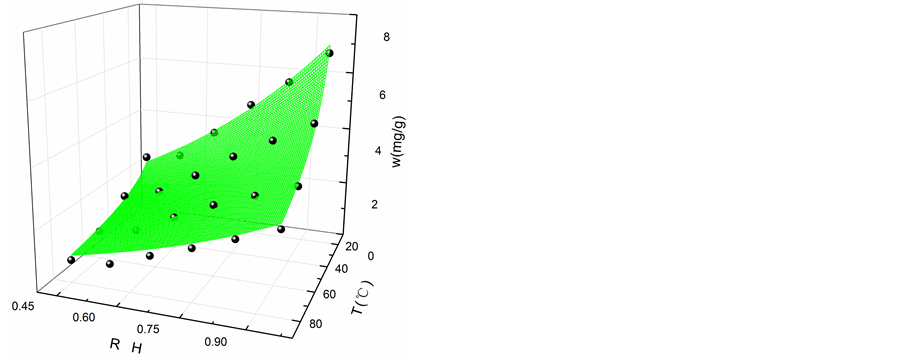Metallurgical Engineering
Vol.1 No.03(2014), Article ID:14136,6 pages
DOI:10.12677/MEng.2014.13010
Study on Moisture Adsorption Equilibrium Model of Lead Concentrate
1Changsha Engineering & Research Institute Ltd. of Nonferrous Metallurgy, Changsha
2School of Energy Science & Engineering, Central South University, Changsha
3Zhuzhou Smelter Group Co., Ltd., Zhuzhou
Email: *yunwenzhu@126.com
Copyright © 2014 by authors and Hans Publishers Inc.
This work is licensed under the Creative Commons Attribution International License (CC BY).
http://creativecommons.org/licenses/by/4.0/



Received: Aug. 25th, 2014; revised: Sep. 8th, 2014; accepted: Sep. 15th, 2014
ABSTRACT
In order to build a more applicative moisture adsorption equilibrium model of lead concentrate, the partial correlation analysis of different factors to moisture adsorption content is conducted basing on the previous experimental works. It shows that the temperature and relative humidity, the correlations are −0.927 and 0.932 respectively, are decisive factors. And then, based on the original Langmuir equilibrium adsorption model, two modified Langmuir models are built by theoretical and empirical methods, which are controlled by the temperature and relative humidity. The analysis and comparison of two models shows that the empirical modified Langmuir equilibrium model is more applicative to the lead concentrates under the 20˚C - 80˚C of temperature and 45% - 95% of RH. So, the empirical modified Langmuir equilibrium model can be employed to calculate the moisture adsorption content of lead concentrates in the industry to some extent.
Keywords:Lead Concentrate, Isotherms Equilibrium Adsorption Model, Correlation Analysis, Langmuir Model

铅精矿吸湿平衡数学模型研究
余 刚1,马 骥2*,廖 舟3,匡至望2
1长沙有色冶金设计研究院有限公司,长沙
2中南大学能源科学与工程学院,长沙
3株洲冶炼集团股份有限公司,株洲
Email: *yunwenzhu@126.com
收稿日期:2014年8月25日;修回日期:2014年9月8日;录用日期:2014年9月15日

摘 要
为了探究并建立更加适用于铅精矿贮存运输过程中的吸湿平衡模型,本文基于铅精矿物料在不同温度、相对湿度和粒径条件下进行的吸附空气中水分实验,结合相关性分析探讨了温湿度、粒径条件对平衡吸湿量的影响,结果表明温度和相对湿度与平衡吸湿量的相关度分别达到−0.927和0.932,为决定性因素。进而基于Langmuir等温吸湿模型,引入温度变量,通过理论推导与经验分析两种途径,分别提出了受温度、湿度共同影响的两种修正Langmuir模型。结合两种模型对实验数据的拟合分析与比较,表明在温度为20℃~80℃和相对湿度为45%~95%的实验条件下,基于经验法修正后的Langmuir吸湿平衡模型可以更为准确地描述铅精矿物料吸湿性能,可以在一定程度上计算生产过程中铅精矿物料的平衡吸湿量。
关键词
铅精矿物料,等温吸湿模型,相关性分析,Langmuir模型

1. 引言
铅精矿是用于悬浮熔炼炉生产金属铅的主要原料。悬浮炼铅工艺要求入炉物料的粒径小于1 mm、含水率小于1%。蒸汽干燥后的物料在贮存、输送过程中,如果物料的吸湿性强,在其输送过程中使含水率超过1%,势必对物料的输送和后续工艺造成影响。一般而言,铅精矿物料的平衡吸湿量亦会受到温度、相对湿度与物料粒径等环境、自身因素的影响。故探究各影响因素对铅精矿平衡吸湿量的影响程度,并建立吸湿平衡模型对铅精矿的贮存输送和悬浮炼铅的生产过程均具有积极的指导意义。
当前,吸附平衡模型主要分为三类,一种是基于实验而得的经验模型,如Freundlich模型[1] ;第二种是基于一定假设的理论推导模型,如Langmuir模型[2] ;第三种为半经验半理论的模型,如LangmuirFreundlich模型[3] 。以上模型较为广泛地应用于水处理与环境工程[4] [5] 、医药工程[6] [7] 、矿物加工[8] [9] 等领域中,并取得了良好的应用结果。但由于其数学形式简单,仅考虑了在等温条件下,吸附浓度对平衡吸附量的影响,故对于受复杂因素所影响的吸附剂而言,上述模型存在一定局限。因此,针对具体物质的吸附平衡模型的研究一直得到研究者们的密切关注。对于活性炭吸附水的过程,根据Langmuir模型提出多分子层吸附理论的BET模型[10] ,并被应用于部分食物的吸湿过程[11] ;对于活性炭吸附有机蒸汽的过程,Jahandar等人考虑活性炭表面不均匀性和孔隙体积的影响,采用了Dubinin-Radushkevich方程[12] ;对于纯针铁矿和沙料对砷的吸附,Gautham P等人引入环境PH的影响,建立了一种修正LangmuirFreunklich(MLF)模型[13] 。这些吸附模型能更为准确地描述特定物料在特定的环境下的吸附状态,这使得吸附理论得到了良好的发展与应用。
故本文将基于铅精矿物料的吸湿实验,定量地分析温度、相对湿度以及物料粒径对其平衡吸湿量的程度,进而从理论推导与经验分析两种途径,分别提出受温度、湿度共同影响的两种修正Langmuir模型,并进行分析与比较。为生产过程中铅精矿物料的正常贮存、输运提供理论依据。
2. 铅精矿物料平衡吸湿量影响因素分析
本研究基于周萍、匡至望等人于2012年所做的温湿度、粒径对铅精矿吸湿性影响的实验[14] 。该实验依据《粉尘物性测试方法(GB/T 16913-2008)》,对铅精矿粉末物料进行吸附水蒸汽性能测试实验。实验中采用经过筛分处理的四种不同粒径分布的试样,其中试样1为实际生产中18目以下的混合粒径试样。实验采用20℃、40℃、60℃和80℃的温度条件以及45%、55%、65%、75%、85%和95%的相对湿度条件。其相关实验结果如图1所示。
在铅精矿物料的贮存与运输过程中,影响铅精矿物理吸湿量的物理因素主要为环境温湿度和物料粒径。为了解各因素对吸湿量变化的影响程度,这里用偏相关分析法进行研究本实验中,相对湿度、温度和粒径都是独立变量,它们之间的相关系数均为0。通过控制温度、湿度和粒径三变量中的任意两个变量,以研究第三变量与物料吸湿量的偏相关程度,偏相关分析结果列于表1。
由表1中可知,吸湿量与相对湿度高度正相关(r = 0.932, α = 0),即随着相对湿度的增大而增大;与


(a) 20℃ (b) 40℃ (c) 60℃ (d) 80℃
Figure 1. The equilibrium moisture adsorption content of samples under different conditions (mg/g)
图1. 不同实验条件下吸湿平衡时的各试样吸湿量mg/g
Table 1. The partial correlation analysis of temperature, relative humidity and particle size to moisture adsorption content
表1. 温度、湿度和粒径对吸湿量的偏相关分析结果
温度高度负相关(r = ‒0.927, α = 0),与物料粒径低度负相关(r = ‒0.426, α = 2.37 × 10−4),即吸湿量随着温度和粒径的增加而减小。从相关性数值来看,相对湿度和温度对吸湿量影响远大于粒径。可以认为温湿度是影响铅精矿物料吸湿性能的绝对因素。
3. 基于理论推导的修正Langmuir吸湿平衡模型
在很多吸附试验中,研究者们发现相对于其他模型,Langmuir等温吸附模型具有较好的适用性[8] [15] 。相应地,在本实验中,铅精矿吸附空气中水分的Langmui等温吸湿模型可由(1)式描述。
 (1)
(1)
式中w为吸湿量;RH为环境相对湿度;b为吸湿常数,与吸附热、吸附温度等有关;a为吸湿常数b与饱和吸湿量we的乘积;
本文将以Langmuir等温吸湿模型作为吸湿平衡模型的基础,进一步引入温度对于吸湿平衡的影响,基于吸湿机理的理论基础,提出同时受温度、相对湿度控制的修正Langmuir吸湿平衡模型。
Langmuir等温吸湿模型的表达式中吸附常数b与吸附热Q和吸附温度T有关[16] :
 (2)
(2)
其中 ,
, ,
, 为Avogadro常数;
为Avogadro常数; 是每个吸附分子占据面积;M为分子量;
是每个吸附分子占据面积;M为分子量;
 为吸附时间;
为吸附时间; 是吸附分子振动时间,它与固体表面原子的振动时间有相同数量级,大约在10‒14~10‒13
s之间,故常令
是吸附分子振动时间,它与固体表面原子的振动时间有相同数量级,大约在10‒14~10‒13
s之间,故常令 。
。
将两式代入(2),整理得:

进一步整理后为:

若令 ,
, ,
, 则:
则:
 (3)
(3)
上式(3)即为理论修正的Langmuir吸湿平衡模型。
根据前文论述,将试样1在20℃时的实验数据带入该模型进行拟合,可确定上述模型中的相关参数与拟合效果,拟合图如图2所示,模型参数列于表2。

Figure 2. The surface fitting based on theoretical modified Langmuir equilibrium adsorption models
图2. 理论修正Langmuir吸湿平衡模型拟合结果图
表2. 理论修正的Langmuir模型的拟合参数与评价
4. 基于经验修正的Langmuir吸湿平衡模型
由上文的相关性分析可知,铅精矿物料吸湿量与温度和相对湿度直接相关,同时根据经验,温度对于吸湿量的偏相关关系大致符合 的关系,c为常数。考虑到温度、相对湿度对于吸湿量的综合影响,将原有Langmuir等温吸湿模型改写为由温度、相对湿度控制的修正Langmuir模型:
的关系,c为常数。考虑到温度、相对湿度对于吸湿量的综合影响,将原有Langmuir等温吸湿模型改写为由温度、相对湿度控制的修正Langmuir模型:

式中,we、b、c均为常数,则上式可简化为:
 (4)
(4)
其中 ,亦为常数,(4)式即为基于经验修正的Langmuir吸湿平衡模型。
,亦为常数,(4)式即为基于经验修正的Langmuir吸湿平衡模型。
同上,将试样1在20℃时的实验数据带入该模型进行拟合,可得上述模型中的相关参数与拟合效果,拟合图如图3所示,模型参数列于表3。
从两个数学模型的拟合评价指标来看,两数学模型在一定程度上能反应吸湿量随温度变化的特征,同时采用基于经验修正的Langmuir吸湿平衡模型(MSE = 0.05768, R2 = 0.97677)更能精确描述铅精矿平衡吸湿量。由此铅精矿物料吸湿平衡时的吸湿量可(5)式计算:
 (5)
(5)
5. 结论
本文选择基于铅精矿物料吸湿平衡的实验研究结果,通过温度、湿度和粒径变化对于物料吸湿量的

Figure 3. The surface fitting based on empirical modified Langmuir equilibrium adsorption models
图3. 经验修正Langmuir吸湿平衡模型拟合结果图
表3. 经验修正Langmuir模型对试样1拟合参数与评价
相关性分析,探究了各因素对平衡吸湿量的影响程度;进而通过理论推导和经验修正两种方法,分别提出受温度、相对湿度共同控制的修正Langmuir吸湿平衡模型,用以描述铅精矿物料吸湿平衡特性。本文主要结论如下:
1) 实验中所涉及的影响因素中,环境温度和相对湿度对吸湿量的有着决定性影响作用,吸湿量与相对湿度高度正相关(r = 0.932, α = 0),与温度高度负相关(r = ‒0.927, α = 0),与物料粒径低度负相关(r = ‒0.426, α = 2.37 × 10‒4);
2) 本文在Langmuir等温吸湿模型的基础上,分别提出了受温度、湿度共同控制的理论修正Langmuir模型, ,以及经验修正Langmuir模型,
,以及经验修正Langmuir模型, ;
;
3) 在温度为20℃~80℃,相对湿度为45%~95%的条件下,温湿度对铅精矿平衡吸湿量的影响可以按此式计算 (均方差为0.05768;确定系数0.97677)。
(均方差为0.05768;确定系数0.97677)。
参考文献 (References)
- [1] Dada, A.O., Olalekan, A.P., Olatunya, A.M. and Dada, O. (2012) Langmuir, Freundlich, Temkin and Dubinin-Radushkevich isotherms studies of equilibrium sorption of Zn2+ unto phosphoric acid modified rice husk. ApplChem, 3, 38-45.
- [2] Zhang, M., Wang, R., Guo, W., Xue, T. and Dai, J. (2014) Adsorption on three contrasting Chinese soils treated with two sources of dissolved organic matter: I. Langmuir and Freundlich isotherm evaluation. Soil and Sediment Contamination Mercury (II): An International Journal, 23, 49-62.
- [3] Yang, R.T. (1997) Gas separation by adsorption processes. Imperial College Press, London, 156-161.
- [4] Nounou, M.N. and Nounou, H.N. (2010) Multiscale estimation of the Freundlich adsorption isotherm. International Journal of Environmental Science & Technology, 7, 509-518.
- [5] Campbell, L.S. and Davies, B.E. (1995) Soil sorption of caesium modelled by the Langmuir and Freundlich isotherm equations. Applied Geochemistry, 10, 715-723.
- [6] Vadi, M., Mansoorabad, A.O., Mohammadi, M. and Rostami, N. (2013) Investigation of Langmuir, Freundlich and Temkin adsorption isotherm of tramadol by multi-wall carbon nanotube. Asian Journal of Chemistry, 25, 5467-5469.
- [7] 谭艳芝, 王秀芳, 钟国英 (2010) 新型竹活性炭对水体违禁药物孔雀石绿吸附性能的影响. 中南大学学报(自然科学版), 41, 1287-1291.
- [8] Xia, L.X., Shen, Z., Vargas, T., Sun, W.J., Ruan, R.M., Xie, Z.D. and Qiu, G.Z. (2013) Attachment of Acidithiobacillus ferrooxidans onto different solid substrates and fitting through Langmuir and Freundlich equations. Biotechnology Letters, 35, 2129-2136.
- [9] 胡岳华, 周苏阳, 孙伟, 陈攀 (2012) 铝土矿反浮选新型捕收剂TR浮选性能及机理. 中南大学学报(自然科学版), 43, 1206.
- [10] Diya’uddeen, B.H. (2013) Comparison of BET and water adsorption techniques. American Journal of Engineering and Applied Sciences, 6, 282-285.
- [11] Pantuso, F.S. (2014) A BET approach to multiayer adsorption in swelling products. Journal of Food Engineering, 122, 68-71.
- [12] Jahandar Lashaki, M., Fayaz, M., Niknaddaf, S. and Hashisho, Z. (2012) Effect of the adsorbate kinetic diameter on the accuracy of the Dubinin-Radushkevich equation for modeling adsorption of organic vapors on activated carbon. Journal of Hazardous Materials, 241, 154-163.
- [13] Jeppu, G.P. and Clement, T.P. (2012) A modified Langmuir-Freundlich isotherm model for simulating pH-dependent adsorption effects. Journal of Contaminant Hydrology, 129, 46-53.
- [14] 周萍, 匡至望, 夏中卫, 廖舟 (2012) 温湿度与粒径对铅精矿吸湿性影响的实验研究. 热科学与技术, 11, 307- 311.
- [15] Ali, W. and Hussain, M. (2013) Evaluation of Freundlich and Langmuir isotherm for potassium adsorption phenomena. International Journal of Agriculture and Crop Science, 6, 1048-1054.

NOTES
*通讯作者。
